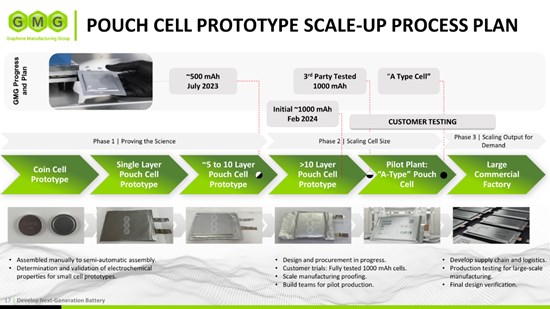Graphene Manufacturing Group Ltd. (TSXV: GMG) (“GMG” or the “Company”) is pleased to provide the latest progress update on its Graphene Aluminium-Ion Battery technology (“G+AI Battery”), which is being developed by GMG and the University of Queensland (“UQ”).
Notably, this update includes information about GMG’s G+AI Battery regarding:
- Electrochemistry optimisation
- 1000 mAh battery cell capacity reached (Previously)
- Battery technology readiness level
- Next steps toward commercialisation and market applications
- Next-generation battery performance
- Important milestones for GMG’s Graphene Aluminium-Ion Battery development
Electrochemistry optimisation
The Company is currently optimising the G+AI Battery pouch cell electrochemistry, a standard step in the battery development process (please see the Battery Technology Readiness Level section below).
Since achieving the targeted 1 Ah cell capacity in February 2024, the Company has developed significant knowledge regarding the pouch cells’ electrochemistry.
The challenges that the G+AI Battery is showing through this phase of its maturation are very similar to those of other battery chemistries that have been developed for mass production, including Lithium-Ion batteries.
The pouch cells’ performance will be communicated upon successfully producing a repeatable and third-party tested 1000 mAh+ battery pouch cell.
The Company is confident it can meet its overall timeline on the battery cell roadmap as seen in Figure 1 as previously communicated.
Figure 1: Battery Cell RoadmapThere are five steps in this optimisation process, which the Company completes once per week in what it calls a “Sprint”, as seen in Figure 2.
Figure 2: Optimisation Weekly Sprint Process
1. Make Cell
The major components of the G+AI Battery are:
Cathode: Graphene, binder and solvent (water or another solution) layered on a metal foil cathode substrate.
Anode: Aluminium foil
Electrolyte: Aluminium Chloride and ionic fluid (Urea or another solution)
Separator: Separator
These are assembled in a standard step-by-step process documented in the Company’s operation manual, which lists procedures for the battery development process.
There are many different variations that can be trialled in a cell design, which can include, but are not limited to, the following:
- Processing of the graphene
- Type of cathode solvent
- Type of cathode binder
- Cathode thickness
- Various ionic fluids in the electrolyte
- Various mixes of electrolyte components
- Types of separators (different materials, suppliers and thicknesses)
- Various cathode preparation variations
- Various cell assembly process variations
- Charging and discharging algorithms (including charging voltage, current and time)
- Formation Processes
Typically, 5 of each battery design is made, which ensures a statistical depth to the testing.
2. Test cell performance
Once the Cell Performance is measured (on the charging/discharging stacks), there are specific performance parameters that are observed, which include, but are not limited to, the following:
- Capacity (mAh)
- Nominal Voltage (Volts)
- Number of Charging and Discharging Cycles (number)
- Physical expansion or contraction of the cell
- Physical changes to the cell
This data is then recorded and linked to the cell design and assembly process used to make the cell.
3. Compare cell performance
This step aims to understand what design and cell assembly parameters, in an isolated test, have a repeatable causal change in cell performance.
Each Sprint usually focuses on a single variable in design or cell assembly—Figure 3 shows an example of a 3-week Sprint program.
Figure 3: Sprint Program Example
4. Review optimisation options
When reviewing optimisation options for the next Sprint, it’s crucial to conduct a comprehensive review. It’s important to remember that a design parameter or assembly process that enhances one cell’s performance outcome may harm another. As the Company aims to optimise various performance outcomes of the battery cell – as shown in Figure 4 – it’s crucial to consider the potential trade-offs on other performance outcomes. This careful consideration is key to making informed decisions.
Figure 4: Battery Optimisation Process
Propose next cell design (repeat Step 1 again)
Once the Company has selected the design of the Cell parameters, it needs to test for optimisation. This involves repeating step 1 until a final design or variable is chosen.
1000 mAh battery cell capacity reached
The Company previously announced on the 6th of February 2024 that it produced multiple battery pouch cells with over 1000 mAh (1 Ah) capacity, as seen in Figure 5. This was a major milestone achieved to demonstrate scalability from coin cells to pouch cells and represented the next milestone in the battery’s development, following the announcement of 500 mAh capacity in September 2023.
Figure 5: Typical G+AI Pouch Cell Prototype
Please see the typical charging and discharging curve of the GMG’s Graphene Aluminium-Ion Battery 1000 mAh cell in Figure 6, showing a nominal voltage of 1.7 volts.
Figure 6: Typical Charging and Discharging Curves
At the same time, GMG is reviewing a potential investment for procuring and installing an automated pouch cell battery pilot plant in its Richlands Australia Facility. The Pilot Plant will enable the Company to produce pouch cells for potential customers to test in battery packs for different applications. Following the pilot plant’s successful start-up and customer trials, GMG expects to pursue large-scale commercial production, as seen in Figure 7.
Figure 7: Pouch Cell Scale Up Process
Battery technology readiness level
The battery technology readiness level (“BTRL”) of the Graphene Aluminium-Ion technology remains at Level 4 (see Figure 8). GMG is currently optimizing electrochemical behaviour for pouch cells via ongoing laboratory experimentation. If GMG invests, constructs and commissions a Pilot Plant it is anticipated that the battery technology will progress to BTRL 7 and 8 since the equipment and process needed to make the Graphene Aluminium-Ion batteries is the same as those employed to make Lithium-Ion Batteries.
Figure 8: Battery Technology Readiness Level
Source: “The Battery Component Readiness Level (BC-RL) Framework: A technology-specific development framework”, Matthew Greenwood et al
Next steps toward commercialisation & market applications
The Company continues to see a broad range of applications for a completed GMG Graphene Aluminium Ion Battery – utilising its ultra-high power-density and nominal energy density characteristics. Along with Rio Tinto, a range of global companies have confidentially expressed their interest in working with GMG in the following vertical sectors:

Next-generation battery performance
GMG’s next-generation Graphene Aluminium-Ion Battery performance data (as tested and calculated on coin cells), as compared to the most commonly available lithium-ion batteries, is shown below in Figure 9, with a list of its beneficial characteristics.
The performance of the pouch cells will be communicated upon successfully producing a repeatable and fully 3rd party tested 1000 mAh+ battery pouch cell.
Figure 9: Graphene Aluminium Ion Battery Comparative Performance Data (for coin cells)
Pouch cell performance data could be significantly different and will be published once 1000 mAh+ capacity pouch cells are developed and tested.
Source: *University of Queensland validated GMG testing data based on industry standard estimate methodology from coin cells using a reducing factor of 2.3. #CATL 3.7V 65Ah NCM Lithium Battery Cell - LiFePO4 Battery (lifepo4-battery.com) on 29/09/22 7 $ CATL 3.2V 150Ah LiFePO4 Battery Cell - LiFePO4 Battery (lifepo4-battery.com) on 29/09/22
About GMG
GMG is a clean-technology company which seeks to offer energy saving and energy storage solutions, enabled by graphene, including that manufactured in-house via a proprietary production process.
GMG has developed a proprietary production process to decompose natural gas (i.e. methane) into its elements, carbon (as graphene), hydrogen and some residual hydrocarbon gases. This process produces high quality, low cost, scalable, ‘tuneable’ and low/no contaminant graphene suitable for use in clean-technology and other applications. The Company’s present focus is to de-risk and develop commercial scale-up capabilities, and secure market applications.
In the energy savings segment, GMG has focused on graphene enhanced heating, ventilation and air conditioning (“HVAC-R”) coating (or energy-saving paint), lubricants and fluids. In the energy storage segment, GMG and the University of Queensland are working collaboratively with financial support from the Australian Government to progress R&D and commercialization of graphene aluminium-ion batteries (“G+AI Batteries”).
GMG’s 4 critical business objectives are:
- Produce Graphene and improve/scale cell production processes
- Build Revenue from Energy Savings Products
- Develop Next-Generation Battery
- Develop Supply Chain, Partners & Project Execution Capability






















